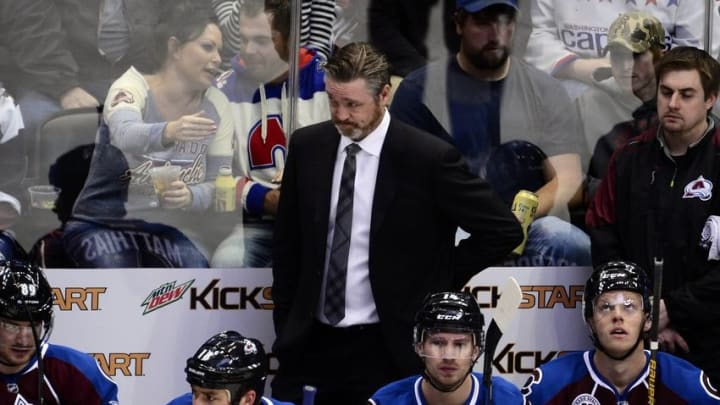To be competitive in today’s NHL, the Colorado Avalanche need to find a new religion: Advanced Statistics.
Our lovely editor, Nadia, recently wrote in praise of Patrick Roy and Joe Sakic’s opposition to advanced statistics and analytics:
Related Story: Colorado Avalanche Analytics: Hockey is not Baseball
As has often been the case since my arrival at Mile High Sticking, I’m going to have to go ahead and respectfully disagree with Nadia. Advanced Statistics are an important tool in developing a competitive style and acquiring the right players, and the Colorado Avalanche management would benefit from using them.
Debunking Roy’s quote
Patrick Roy’s thoughts on ‘Fancy Stats’, specifically the Corsi statistic, can be encapsulated in one quote:
"“The part I don’t like about Corsi is you could shoot from the red line or […] from a terrible angle and your Corsi will look good” ~Patrick Roy"
While I’ll rant further, I want to start by debunking this quote with a lovely video from 2015 of our recently bought out friend, Brad Stuart:
Now obviously this is a bit of a fluke goal, and obviously an NHL elite goalie like Corey Crawford is going to save shots (if you can call it a shot) from center ice 99.99% of the time. However, this goal goes to prove the central line of thinking behind the Corsi stat: you can only score goals if you shoot, and you can only shoot if you have the puck. Or, to put it in terms of a Hall of Fame member (since we love our hall of famers here):
"“You Miss 100% of the shots you don’t take” ~Wayne Gretzky, the Great One"
What is Corsi, and why is it useful?
Corsi accounts for shots on net, shot attempts that miss, and shot attempts that are blocked. There is a Corsi For (CF) and Corsi Against (CA), which can be combined into the composite stat, Corsi For Percentage (CF%).
This stat is used as one metric of possession, simply because if you have the puck more, you’ll shoot the puck more.
Corsi is useful because it allows coaches to study the systems of better possession teams, who typically are also the top teams in the league. Don’t believe me? Look at this year’s Stanley Cup Champions, the Pittsburgh Penguins, who were ranked second in CF% with a score of 52.7%, who defeated the ninth ranked San Jose Sharks.
In fact, ten out of the sixteen playoff teams finished in the top half of the league when it comes to CF%. This should concern Avs fans, as this past year, we finished dead last, with a CF% of 44.2%. Roy can say what he will, but systems that result in a good Corsi ranking often produce playoff teams.
Related Story: ‘Staying the Course’ is Fine, Maybe
Why does Roy resist Advanced Stats?
I can only really speculate here, but if I had to guess, I’d say there are two reasons:
- Roy was a goalie in his playing days, and sees the game through that lens.
- His systems worked in the QMJHL, which may be more forgiving of non-possession-oriented hockey.
From a goalie’s perspective, especially one as good as Roy, facing lots of low-quality shots might seem ideal as opposed to a less frequent but higher quality shot. It also may seem better for a goalie if a defender blocks a shot rather than pressure the puck and try to force a turnover.
More from Mile High Sticking
- Could Colorado Avalanche move on from Pavel Francouz next offseason?
- 4 goalies to replace Pavel Francouz if he has to miss time
- Colorado Avalanche make sneaky signing with Tatar
- Colorado Avalanche captain Gabriel Landeskog could return in 2023-24 playoffs
- Colorado Avalanche rookie face-off tournament roster
While this may have been a serviceable old-school approach, it doesn’t seem to work in today’s NHL. With deflections becoming a bigger part of goal scoring, and more lenient rules concerning the crease, forwards need to be pressured into screwing up, even if it results in the occasional quality chance.
In the QMJHL, young players still have a significant amount of development to do before they hit their prime. In many cases, they’re more mistake-prone and less cerebral on both sides of the puck, which leads to more wide-open but sloppier hockey. In addition, the goaltenders also have a ways to go with development, so the overall quality level is just significantly lower.
In the ‘Q’, Roy’s systems likely worked because it was a ‘play it safe’ system being used against a bunch of developing and volatile teenagers. With mistakes committed more frequently, the Remparts were able to take advantage of the opposition working against itself, and succeed with low possession numbers.
In the NHL, where mistakes are more rare, a playoff-bound team has to force mistakes out of its opposition, and turn low-quality shots into goals.
Is embracing Advanced Stats everything?
No. Obviously, a playoff team must have highly skilled and intelligent players to be successful. This was the case with the Toronto Maple Leafs this past season.
Toronto, under the superb coaching of Mike Babcock, earned themselves the thirteenth best CF% at 51.3%, better than the Presidents’ Trophy-winning Washington Capitals. However, Toronto was also in the middle of a fire sale this season that saw their top talent at every position eventually depart as they commit to a full rebuild. This ultimately led to them finishing last in the League and drafting first overall.
Next: Colorado Avalanche: AHL Trent Vogelhuber
The Avs, for the most part, have the talent to make the playoffs. They have two excellent goaltenders, several strong forwards, and a collection of average defenders. If only they had the puck.
